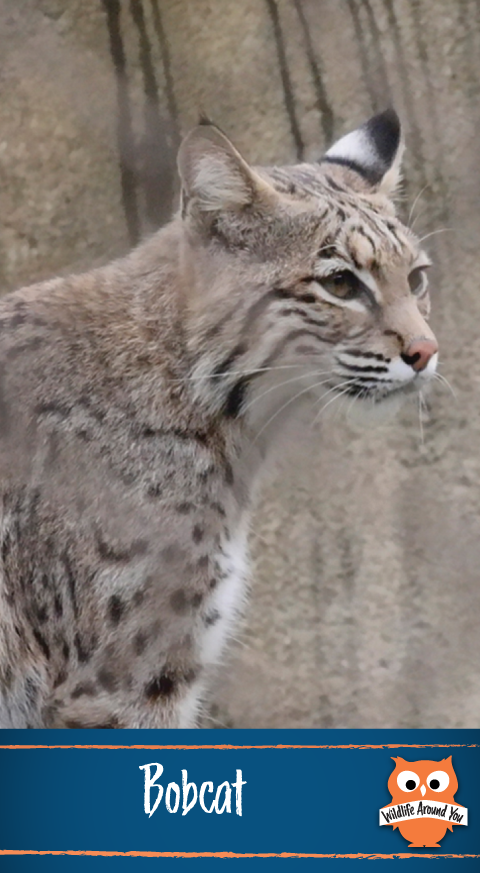Also known as the red lynx, is a medium-sized cat native to North America from southern Canada, most of the contiguous United States to Oaxaca in Mexico.
The bobcat is the smallest of the four lynx species. There are 12 subspecies of bobcats.
Identification
Has distinctive black bars on its forelegs and a black-tipped, stubby (or “bobbed”) tail, from which it derives its name.
About twice as large as the domestic cat. Its spotted patterning acts as camouflage. The ears are black-tipped and pointed, with short, black tufts. They have black pointed ears, similar to the lynx, with a white patch in the center of each ear. They also have a thin white lining on the fur around their eyes.
Generally, an off-white color is seen on the lips, chin, and underparts.
The adult bobcat is 18 to 49 in. long from the head to the base of its distinctive stubby tail.
An adult stands about 12 to 24 in. at the shoulders. Adult males can range in weight from 14 to 40 lb
Bobcat tracks show four toes without claw marks, due to their retractable claws. The tracks can range in size from 1 to 3 in. When walking or trotting, the tracks are spaced roughly 8 to 18 in. apart.
The bobcat can make great strides when running, often from 4 to 8 ft. Like all cats, the bobcat ‘directly registers’, meaning its hind prints usually fall exactly on top of its fore prints.
Habitat
Wooded areas, as well as semidesert, urban edge, forest edge, and swampland environments. the bobcat is territorial and largely solitary, although with some overlap in home ranges.
It uses several methods to mark its territorial boundaries, including claw marks and deposits of urine or feces.
Nesting
In its territory, the bobcat has numerous places of shelter, usually a main den, and several auxiliary shelters on the outer extent of its range, such as hollow logs, brush piles, thickets, or under rock ledges. Its den smells strongly of the bobcat.
Behavior
The cat has sharp hearing and vision, and a good sense of smell. It is an excellent climber and swims when it needs to, but normally avoids water.
It is active mostly during twilight. It keeps on the move from three hours before sunset until about midnight, and then again from before dawn until three hours after sunrise.
Each night, it moves from 2 to 7 miles along its habitual route.
Offspring
The mating system of bobcats is similar to that of domestic cats. Males and females are only together for the brief time required for courtship and mating, and both males and females may have more than one mate.
It breeds from winter into spring and has a gestation period of about two months. Kittens are born well-furred and already have their spots.
The average bobcat lifespan is 7 years long and rarely exceeds 10 years.
The female raises the young alone. One to six, but usually two to four, kittens are born in April or May, after roughly 60 to 70 days of gestation. Sometimes, a second litter is born as late as September.
The female generally gives birth in an enclosed space, usually a small cave or hollow log. The young open their eyes by the ninth or tenth day. They start exploring their surroundings at four weeks and are weaned at about two months. Within three to five months, they begin to travel with their mother.
Predators
Predators of the bobcat include cougars and wolves. The kittens are preyed upon by coyotes and owls. 38 states, seven Canadian provinces, and Mexico allow for some types of bobcat hunts.
Thousands of bobcats are harvested for the fur industry each year, invasive pythons in Florida are decreasing their numbers in the Sunshine State, and rodenticides kill bobcats as they consume targeted species.
Diet
The bobcat prefers rabbits and hares, it hunts insects, chickens, geese and other birds, small rodents, and deer. Prey selection depends on location and habitat, season, and abundance.
The bobcat is able to survive for long periods without food but eats heavily when prey is abundant.
Fun Facts
Bobcats are able to jump as high as 12 feet.
The top speed of a bobcat is 34 mph.
Bobcats rarely attack people. They are easily spooked by humans, so if one attacks, it may have rabies.
In Native American mythology, the bobcat is often twinned with the figure of the coyote in a theme of duality.
In Native American symbolism, the bobcat represents clear vision in dark places, vigilance, patience, and the ability to see through masks.
The bobcat and coyote are associated with the fog and wind, respectively—two elements representing opposites in Native American folklore.
In a Shawnee tale, the bobcat is outwitted by a rabbit, which gives rise to its spots. After trapping the rabbit in a tree, the bobcat is persuaded to build a fire, only to have the embers scattered on its fur, leaving it singed with dark brown spots.
Of all the wild cats in North America, the bobcat has the largest range and is also the most abundant.

